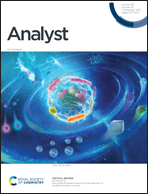CuI-p-DPA coordination polymer isomers for “turn-on” fluorescence detection of thiophanate-methyl†
Abstract
Three copper iodide coordination polymer (CuI-p-DPA) isomers were prepared from the fluorescent organic ligand p-DPA and cuprous iodide (CuI) under different solvothermal conditions, which exhibited quenched fluorescence behaviors after forming coordination polymers (CPs). These CuI-p-DPA isomers showed discrepant fluorescence responses to thiophanate-methyl (TM). Among these CuI-p-DPA isomers, α-CuI-p-DPA exhibited the maximum fluorescence enhancement after its incubation with TM in aqueous solution. The fluorescence enhancement mechanism was that TM competed with the ligand p-DPA to coordinate with CuI clusters, and then α-CuI-p-DPA released p-DPA into the solution and induced fluorescence enhancement. The present detection method possesses the advantages of good selectivity, high sensitivity, short response time, and strong anti-interference ability with a linear range of 0.5–100 μM and a detection limit of 0.01 μM. This study not only reveals that the spatial structures of CPs play an important role in the fluorescence response ability, but also provide a new fluorescence signal-on analysis method to rapidly and sensitively determine the pesticide residue for TM.

- This article is part of the themed collection: Analyst HOT Articles 2023


 Please wait while we load your content...
Please wait while we load your content...